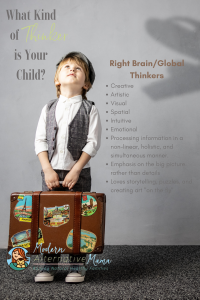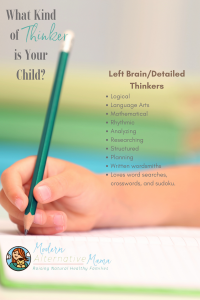By Rustina
We all spend quite a bit of time in our heads thinking, but the results vary so much. How can two people take the same data, give it real thought, and still reach such different opinions? This is something I often debate when it comes to my kids. How can I say the same thing to my kids, and yet, all of them take it so differently?
Our experiences, education, and genetics have a lot to do with it. But more than just what we think, something else also affects it, too – how we think. The last couple of centuries led to analyzing brain functions and lateralization. Similar to how referencing learning styles were dropped after public school settings found it unhelpful in a classroom, right-brain/left-brain thinking was also dropped by professionals. Another thinking classification that is more recently popular (since around the 80s) is global thinker vs detailed thinker. They are very similar in nature to right brain/left brain classification. Honestly, I think they just feel better not having the brain hemisphere title there since we obviously use both hemispheres.
People use a combination of all parts of their brains, but sometimes, we can draw more from one side than the other to evaluate the world around us. Just like some students thrive in a class, some students struggle. If you are struggling to help your kiddo, understanding the basics of these dominant thinking styles may be a great place to start or even help create that very connection you have been hoping to fire up.
Let’s dive into identifying the types, their strengths, their struggles, and how to help!
How can you identify what type of thinker your child is and what kind of struggles they are feeling?
People can have a number of any of these traits – in fact, that is ideal! Here are some qualities that stand out with each of these four particular categories of thinking.
Right Brain and Global Thinkers
The right hemisphere is often associated with the following:
- Creative thinking, artistic expression, imagination, and holistic thinking.
- Processing visual information, spatial orientation, recognizing patterns/relationships, and interpreting visual cues are functions typically attributed to the right hemisphere.
- Intuition, emotional perception, empathy, social awareness, and the recognition of non-verbal cues.
- Processing information in a non-linear, holistic, and simultaneous manner.
- Music and art appreciation
- Emphasis on the big picture rather than details
- May enjoy puzzles and painting.
- May find it challenging to communicate ideas clearly and concretely.
- Many prepared lessons are more left-brain centered, which is generally viewed as the least common of the two (most are somewhere in the middle) and makes it hard for right-brain thinkers to process. This often leads to struggles in class, often determined to be bored/fidgety/hyper.
The global thinker is often associated with the following:
- Intuition and gut feelings. By trusting these principles, they can arrive at solutions without following a step-by-step logical process.
- Creative and imaginative, often coming up with out-of-the-box ideas and approaches to challenges.
- Adjusts well to new information or changing circumstances, making them well-suited to dynamic and evolving environments.
- Recognizes patterns, connections, and underlying issues that help create comprehensive solutions.
- Not fond of repetition – may become impatient, bored, or frustrated with repetitive, detail-oriented tasks.
- Often communicates ideas in a way that is easy for others to understand. They use analogies and metaphors to illustrate their points effectively. They are often phenomenal verbal storytellers.
- Global thinkers might become so engrossed in conceptualizing possibilities that they overlook the practicality of ideas and make assumptions about details that may not be accurate.
- Comfortable navigating situations with incomplete, developing information.
- The abundance of ideas and possibilities in their mind can lead to difficulty focusing on a single task or idea, causing them to jump between multiple projects without completing any of them.
- They may go to clean their room and pick up the main things they are “seeing” because some of the smaller things are just little details that do not seem significant. It isn’t willful neglect of detail; it is just how they are currently processing it. (no worries – there are ways to help – keep reading!)
Left Brain and Detailed Thinker
The left hemisphere of the brain is often associated with the following:
- Logical thinking, reasoning, and problem-solving abilities.
- Language processing, speech production, and comprehension tend to be predominantly localized in the left hemisphere.
- Mathematics, numerical reasoning, sequencing, and arithmetic skills are often linked to left-brain functions.
- Analyzing facts and data.
- Researching and debating. They are often phenomenal written wordsmiths.
- The left hemisphere is involved in sequential processing, organizing information step-by-step.
- May enjoy word searches, crosswords, and sudoku.
The detailed thinker:
- Loves specific facts and details.
- Pays close attention to specific elements at times, even super focusing on details. They may see a task as never complete because there are still so many things to do. In some cases, when anxiety is present, they may have trouble starting the task due to all the different variables. Perfectionism is sometimes a common trait for them.
- Detailed thinkers are often meticulous in their approach to problem-solving and may excel at tasks that require precision. Analyzing details can be time-consuming, causing them to take longer to complete tasks than non left-brain dominant thinkers.
- Prefer situations with clear, structured guidelines. They may struggle with abstract ideas or be uncertain if they have enough authority to make choices in a given situation. They need to know the details to start building a picture of the process or at least know that they can fill in those blanks as needed.
- They excel at a systematic, logical approach to problem-solving, breaking down tasks into smaller, manageable steps to achieve their goals.
- Prioritizes accuracy and precision in their work. They are diligent in verifying information and ensuring their work is error-free. Skilled at organizing information in a structured manner. They use outlines, charts, and lists to keep track of data and ideas. In younger children, it is often accompanied with “Mom, is this right? What color should this dinosaur be? Where are we going? What are we doing tomorrow?” They need to make sure they have the information and confirm it often.
- Good memory.
- Patient, enjoying repetition even.
- Carefully weigh the pros and cons of options before making decisions. They tend to be cautious and may be less inclined to take risks without thorough consideration of potential consequences. They consider all relevant factors and potential outcomes. Often called “overthinkers.” They might become so focused on minor details that they lose sight of the main goal or idea, leading to inefficiencies in problem-solving.
- May excel in fine arts, architectural design, or crafts that require meticulous attention to detail. They can still love art and be creative; they just do it with a very detailed plan in their mind.
- They may have difficulty letting go of completed tasks or projects, continually seeking ways to improve or fine-tune their work.
- May struggle to adapt quickly to unexpected changes or disruptions. If given clear communication and time to adjust, this is minimal.
So how can a mama use this information to help her family?
Understanding the idea of the right/left brain and global vs. detailed thinking can be very helpful for parents to support their children’s development and understanding. Of course, we have to remember that the brain works as a whole unit; both hemispheres play a role in tasks. First, we will talk about how it can help, and then, we will share tips for each dominant style.
Encourage a balanced process
Encourage a balanced approach to learning and problem-solving. While some kids may naturally lean toward certain thinking styles, it’s essential to expose them to a variety of activities that engage both the right and left brain. This can include artistic activities (right brain) and logical puzzles or math games (left brain). By knowing which way your child leans towards, you can help add more of the “other side.” Storytelling is great for this. Detailed/left brainers soak up the information shared, while global/right brains love the entertainment and overall messaging. A right brain/global thinker will hear the story associated with a rule or concept (such as grammar rules or math equations) and remember the story thus remembering the rule. A left-brain/detail thinker will hear the rule and contemplate the story for more understanding. Either way, stories can bring both sides together well.
It is natural to tailor learning activities to match their thinking style. If your child enjoys artistic expression, provide drawing, painting, or storytelling opportunities. If they prefer logical challenges, engage them in games or activities that require problem-solving and critical thinking. It is important to slowly open their minds to both sides frequently, though. The more both thought processes are engaged, the better!
Identify their strengths
Observe your child’s interests. You can use this to help build their confidence and self-esteem and understand the aspects they may find more challenging. Some children may excel in artistic endeavors, demonstrating creativity and imaginative thinking (right brain). Others may be naturally analytical and enjoy solving puzzles or math problems (left brain). If you know they are struggling or worried about a new project, lead with their dominant activity, and then work in the opposite side activities to help them gain confidence and balance.
Creativity is not limited to the right brain, and it can be enhanced through activities that encourage imaginative thinking, such as storytelling, pretend play, or prompted creative writing.
Logical thinking and problem-solving abilities can be nurtured through puzzles, strategy games, and activities that require planning and organization.
Provide a motivation that encourages exploration and curiosity. Offer books, educational toys, art supplies, and other resources that support both creative and analytical thinking.
Be Patient and Supportive
Every child is unique, and their cognitive development may unfold at different rates. Be patient and supportive of your child’s learning journey – and yours – providing positive reinforcement and encouragement along the way. Be careful not to compare one child’s journey to another’s often. Whether out loud or in your head, it can become a trap and disadvantage if it starts limiting you or your child.
How can you help each understand better?
To help a right brain or global thinker understand a concept better, consider the following strategies:
- Utilize visual aids, diagrams, charts, and other visual representations to convey information. Hands-on activities and interactive learning experiences can also be effective in enhancing understanding and engagement.
- Encourage and provide opportunities for creative expression and exploration. Allow for open-ended thinking and problem-solving, where multiple solutions are possible. This can stimulate a right-brain thinker’s imagination and help them see connections and possibilities that may not be immediately apparent.
- Provide context and real-life applications. Help right-brain thinkers connect new information to real-life examples, experiences, or scenarios. Understanding the practical applications of concepts can make learning more meaningful and relevant for them. Find historical stories that capture the imagination while delivering the relevant information.
- Encourage group discussions, brainstorming sessions, and cooperative projects that allow them to bounce ideas off others and gain different perspectives.
- They have a strong emotional perception. Help them make connections by highlighting the emotional relevance or implications of the information being presented. This can aid in their understanding and retention of the material.
- It may require more time to process information and make connections. Provide them with ample time to reflect and think independently.
- Encourage the child to actively listen when others speak, emphasizing the importance of paying attention to details in conversations and instructions. Turn it into a game. Ever watch the TV show Psych? The dad often has young Sean close his eyes and describe or answer questions about his surroundings. This teaches the art of noticing the differences and details around you.
- When facing a complex task, help break it down into smaller, manageable steps. This approach can assist them in focusing on the specifics of each step, leading to a more thorough understanding of the overall process.
- Encourage the child to take organized and detailed notes during lessons or while reading. This practice reinforces their ability to capture important information effectively.
- When reviewing the child’s work, provide specific feedback on areas where more attention to detail is needed. Avoid criticizing and focus just on encouraging improvement.
To help a left brain or detailed thinker understand better, consider the following strategies:
- They tend to respond well to logical explanations and reasoning. Present information in a structured and logical manner, outlining the cause-and-effect relationships and step-by-step processes involved.
- Since complex or abstract concepts can be challenging for left-brain thinkers to grasp initially. Break them down into smaller, more manageable components. Provide clear definitions, examples, and concrete applications to help them understand each component before moving on to the next. The more they understand “big picture” ideas now, the more they will see it in the future.
- They value evidence and facts, so support your explanations with relevant data, research findings, and concrete evidence. This strengthens their understanding and provides a solid foundation for their reasoning going forward.
- Clearly define the learning objectives and expectations. They appreciate clarity and structure. Establishing specific goals and outlining the desired outcomes can help them stay focused and motivated. As they grow, have them fill in more of the goals, outlines, and outcomes to start seeing the whole picture coming together.
- They enjoy engaging in intellectual debates and discussions. Encourage them to express their thoughts, challenge assumptions, and engage in analytical conversations with others to deepen their understanding and refine their thinking. The more data they process, the more connections they will see.
- Relating abstract concepts with familiar and concrete examples can aid in their comprehension and make the information more relatable. Stories from your childhood, the bible, books, youtube videos – anywhere! Many stories have a detailed account of the data that lead to the reinforcement of an abstract idea.
- Pose open-ended questions that require the child to consider multiple perspectives and think beyond the immediate details. Encourage them to explore the “why” and “how” behind the facts.
- Help your little thinker understand the cause-and-effect relationships between different elements, showing how small details can contribute to more significant outcomes.
- Introduce the concept of systems thinking, where the child considers how individual components interact to form a larger system or structure.
- Introduce the concept of mind mapping, which helps visualize relationships between ideas and how they connect to the central theme.
Collaborative projects with a variety of thinkers can be beneficial, as they can learn from each other’s strengths and perspectives. Work with your child to set achievable goals for enhancing their attention to detail and the global view. Celebrate their progress and effort as they make improvements. Remember to celebrate your work and progress towards understanding how your family thinks also!
It’s important to remember that thinking styles can vary and may change over time. Most people have a mixture of strengths and struggles. Embrace balance and effort, and time will work in your favor!
Resources:
Over at Earthley, we have been creating study units with a variety of thinkers, learners, and skill levels in mind. Each unit has some cooking, sewing, medicine-making, and foraging help in it. We keep the main instruction very simple and easy to follow while offering ways to advance the learning and offer discussion topics.
Activity Guides and Curriculum
We also have a variety of free activity guides and very affordable curricula such as Real Food, Real Nutrition. These are also with a variety of ages and thinking styles in mind.
Earlier this year, I attended a conference and listened to Robyn Jeffords from Achieve More Reading Center. It was a huge eye-opening moment that helped me see great ways to use right-brain/left-brain ideas to help my son improve his reading.




